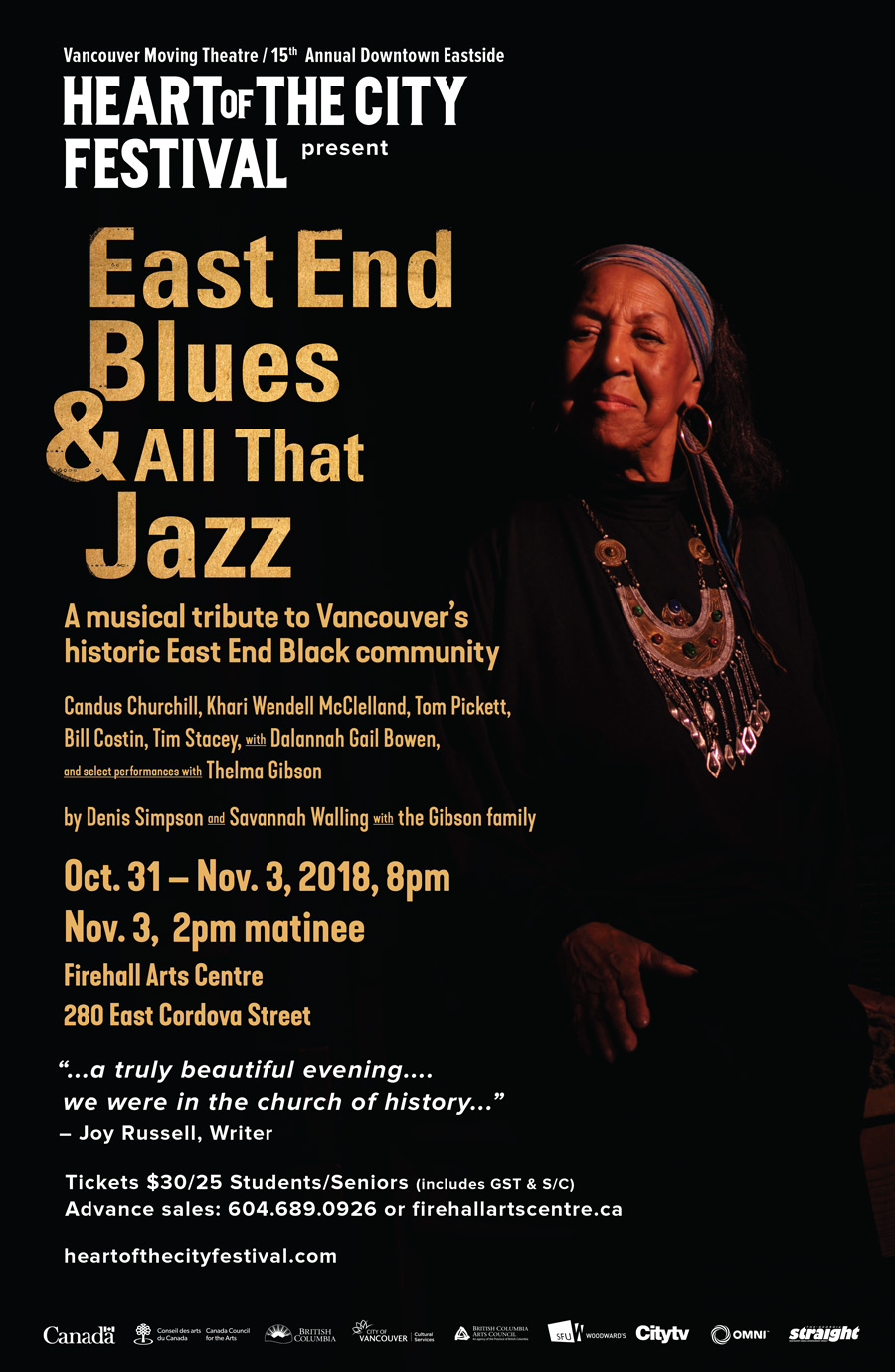East End Blues & All That Jazz
A Musical Tribute to the East End’s historic Black Residential Community
Wednesday to Saturday,
October 31 – November 3, 8 pm
Saturday November 3, 2 pm
Firehall Arts Centre, 280 E. Cordova
$30/$25, at door (incl. GST & service charges)
Advance tix: 604.689.0926;
www.Firehallartscentre.ca
or boxoffice@firehallartscentre.ca
Inspired by stories from residents past and present of Vancouver, East End Blues & All That Jazz is a concert curated and co-written by the late Denis Simpson and Savannah Walling with contributions from the GIbson family and others. The production’s music is directed by Bill Costin and features some of our favourite artists: lead singers Candus Churchill and Tom Pickett, emcee Khari Wendell McClelland, musicians Bill Costin (piano) and Tim Stacey (bass), and guest singers Dalannah Gail Bowen and – at selected performances – Thelma Gibson.
East End Blues & All That Jazz premiered at the 2006 DTES Heart of the City Festival and was remounted in 2009 and 2011, where it sold out before it opened.
Produced by Vancouver Moving Theatre and the Downtown Eastside Heart of the City Festival.
“What an enlightening journey this has been – on a personal as well as an historic level – to delve into the history of the Black community in Vancouver and the East End. Stories and songs of times gone by help us celebrate the past, live in the present and look to the future. They also teach how we can come together as a community – despite our seeming differences – to nurture compassion, understanding and respect; and, to effect positive change.” – Denis Simpson, Co-writer and Director (2006 & 2009)
A MUSICAL FAMILY
“I’m from a show business family. I grew up in the Downtown Eastside and was familiar with, knew or was related to some of the people that will be mentioned in the show. There was always music, old blues, jazz and spirituals in our home. At our family reunion and picnics, everyone HAD to sing, dance or play an instrument. My grandfather played banjo and sang and taught everyone to sing parts. My brother Len was born dancing and did so all his life, he taught us all. The East End was full of talented artists. My dad was a great bluegrass guitarist and taught all of my uncles how to play. My uncle Austin Phillips was a local ballader. Mom sang all the time. McLean Playground used to have dances in the summer at which we would all help.” – Chic Gibson
One hundred years ago, the Gibson siblings’ grandparents, along with 1,000 other black men, women and children, emigrated north from Oklahoma and Texas, leaving behind the post-Civil war racism to build new lives in Alberta and Saskatchewan. Their parents, in turn, left northern Alberta for Vancouver during the early 1930s, leaving behind drought and grasshopper plagues – and the bitterly cold winters.
Chic, Thelma, and Leonard Gibson grew up in Vancouver’s East End where they attended Strathcona School. Leonard choreographed the show routines he and his siblings performed at their parent’s restaurant the Country Club Inn (473-475 East Powell), at night clubs like the Mandarin Gardens Supper Club (98 East Pender), and the Harlem Nocturne (343 East Hastings) run by their uncle trombonist Ernie King and his wife Marcella. All three siblings grew up to be accomplished artists, performing with the Lenny Gibson Dancers, in most of Vancouver’s nightclubs, as well as Theatre Under the Stars and in Bamboula: the first CBC musical variety television series produced in Vancouver. Created by Leonard, Bamboula was the first program with an interracial cast, and included Vancouver’s “first lady of jazz” Eleanor Collins (Order of Canada).
The first black dancer in Canada to train in classical ballet, Leonard went on to dance, choreograph and teach across North America and Europe. Their brother Sylvester Risby performed for over forty years with the Night
Train Review. Chic performed in nightclubs, theatre, TV, and was the first Black Canadian to work for BC Hydro. Thelma toured internationally, worked in nightclubs in Canada, Europe and the West Indies and taught Afro-Cuban drumming and dance to upcoming generations in Vancouver. The siblings received multiple honours and awards for their contributions to the black community and for their achievements in the performing arts. Thelma’s motto: “There’s no such word as can’t”.
HOGAN’S ALLEY
According to Places That Matter, a community history resource, “Hogan’s Alley was the unofficial name for a T-shaped intersection at the southwestern edge of Strathcona that formed the nucleus of Vancouver’s first concentrated black community.” The ethnically diverse area was home for many black families, black businesses, and the city’s only black church — the African Methodist Episcopal Fountain Chapel. Most of the alley was destroyed in the early 1970s by the construction of the Georgia Viaduct, the first phase of a planned interurban freeway. The freeway was stopped by a grassroots community action, but not before the Georgia Viaduct Replacement Project demolished many of the areas buildings, displaced its businesses, and displaced the city’s first and last concentrated residential black community.
"The name Hogan’s Alley first appeared back in 1895 in a comic strip about a lively working class New York City neighbourhood; soon districts all over North American were dubbed Hogan’s Alley. By the 1920s and 1930s, the name was applied to this East End area brimming with life – not in the alley of course – but emanating from the cafes, nightclubs, eateries, businesses, and bootlegging houses spread along either side, run by Italian, Chinese and black entrepreneurs. People from the West End joined working Eastenders for good food, relaxation, and laughter while well-heeled men did business or political deals in the back groups.” – East End Blues & All that Jazz

